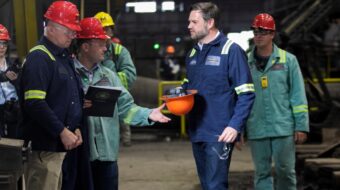WASHINGTON – A task force of union and foundation leaders is pushing a comprehensive plan for creating new well-paying middle-class jobs – even as a separate report reveals what most workers already know: Those jobs that have been created since 2001, in recession or in recovery, pay little.
“Industries that once were great contributors to our country – auto, shipbuilding, machine tools and even electronics – are shadows of what they once were,” declares the Task Force on Job Creation, in its report, released in late July. Steelworkers President Leo Gerard and Leo Hindery of the New American Foundation co-chaired the task force.
Their report comes just as the National Employment Law Project released its own study, July 26, showing that what little job growth has occurred since the official end of the Great Recession in mid-2009 has been in low-wage jobs. And before that, 60 percent of the job losses were in mid-wage jobs, NELP said.
Four million middle-income jobs disappeared during the two years of the crash. Over a million higher wage jobs and 1.25 million lower waged jobs disappeared during the same period, according to government figures.
“In the weak recovery to date, employment growth has been concentrated in lower-wage occupations, with minimal growth in mid-wage occupations and net losses in higher-wage occupations. From the first quarter of 2010 through the first quarter of 2011, lower-wage occupations grew by 3.2 percent, with retail salespersons, office clerks, cashiers, food preparation workers and stock clerks topping the list. Mid-wage occupations grew by only 1.2 percent and higher-wage occupations declined by 1.2 percent,” NELP said.
The labor-foundation task force presented 15 recommendations. Among them: Creating a National Infrastructure Bank to use federal loans and loan guarantees to leverage private capital for nationally valuable construction. The task force also wants to link a 10 percent investment tax credit – which firms now get for investing in equipment – directly to “rehabilitation and renovation of existing manufacturing facilities,” which “could pump billions of dollars into the modernization of America’s plants.”
And it advocated government cash grants for renewable energy production.
The task force also said Congress should enact temporary tariffs to help cut the annual $600 billion-plus annual U.S. trade deficit. It urged establishment of a special U.S. Justice Department office to enforce trade laws against nations that illegally subsidize their goods, and it later singled out China. It also wants the government to initiate its own trade cases against foreign subsidizers, rather than waiting for hurt industries – or unions – to marshal the evidence and make the case.
And it criticized the U.S. Trade Representative, now responsible for trade policy, as being more interested in negotiating trade treaties than in enforcing them.
Task force members also called for stronger buy-U.S. standards.
“No single measure would do more to help resuscitate U.S. employment, particularly in manufacturing, than a buy-domestic government procurement requirement that is consistent with our international trade obligations,” their report says. It also advocates safeguarding national security-essential manufacturing, a longtime Machinists cause.
And the task force demanded Congress “eliminate the tax incentives that encourage American companies to invest overseas rather than here at home.” Instead the government should “provide financial and legal inducements for corporations to provide good jobs for Americans.” And government programs should be required to produce “employment impact statements” about job creation, just like other projects now require environmental impact statements.
One of the task force’s long-tern recommendations harkens back to FDR’s New Deal.
“As the U.S. economy strengthens and the deficit shrinks, the government should consider a 21st century version of Franklin Roosevelt’s Works Progress Administration.
“Roosevelt put millions of Americans back to work in 1935 by creating jobs that improved living conditions and generated new wealth. Today’s unemployed can be put to work renovating factories and installing new equipment, devising new financing, marketing and sales packages for local business, and reinventing the way we deliver skills. Providing counties and communities with the federal dollars to hire the unemployed will improve our global competitiveness and jump-start depressed local economies,” it said.
In its report, NELP agreed with the labor-foundation task force that high-paying jobs are disappearing.
“While it is too early to predict whether these trends will continue, the dominant growth in lower-wage occupations suggests there is a good jobs deficit that has hollowed out many of the decent work opportunities people are looking for,” said NELP report author Annette Bernhardt, the group’s policy co-director.
Other union leaders on the jobs task force included Machinists President Tom Buffenbarger and former SEIU Secretary-Treasurer Chair Anna Burger.










